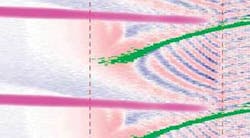For many researchers working with high-intensity lasers, plasma formation is often bad news. For others, it’s an enabling step for putting their laser systems to good use, in the form of so-called plasma mirrors. Now, collaborators at CEN Saclay (Gif-sur-Yvette, France), École Polytechnique (Palaiseau, France), and the University of Toronto (Toronto, Ont., Canada) have used a chain of plasma mirrors to create extreme-ultraviolet (EUV) pulses that they predict to be on the attosecond timescale, all with a tabletop laser.1
In the highest intensity femtosecond-laser systems, a nanosecond-scale prepulse can be enough to ablate the surface of samples before most of the pulse energy arrives. Enter the plasma mirror, a simple but effective solution to increase the contrast between the prepulse and the main pulse. By placing a highly polished mirror blank in the beam at Brewster’s angle, the nanosecond-scale prepulse passes unchanged. The rising edge of the main pulse, however, converts the surface of the mirror into a highly reflective plasma, specularly reflecting only the main pulse.
Fabien Quéré, who leads the attosecond-pulse research at the Department of Research in Condensed Matter, Atoms, and Molecules at CEN Saclay, says that the research uses the first permanent implementation of a fully engineered plasma-mirror-based system. “We got these results just after having installed our double plasma mirror for contrast improvement,” Quéré says, “and we have been surprised by how easy it is to use on a daily basis.”
Relativistic electrons
Once the prepulse is cleaned up by two plasma mirrors, a third forms the basis for high-order harmonic generation (HHG). Much research has focused on HHG generation in plasmas, with the presumed mechanism being the relativistic oscillating-mirror (ROM) process. The ROM effect happens when the intense laser field drives the surface of the plasma, causing the electrons to oscillate at relativistic speeds. The periodic phase modulation in the reflected beam gives rise to harmonics of the laser frequency. Such HHG is widely regarded as a phenomenon that occurs only in very large lasers-accomplished, for instance, by the Queen’s University Belfast’s Matthew Zepf and colleagues at the Vulcan facility (Didcot, England).2 But last year, Quéré’s group showed that harmonics up to the 18th order could be formed with just a few millijoules, far below the intensity threshold for ROM.3
To explain the result, the authors proposed a theory called coherent wake emission (CWE). The theory posits that as the plasma oscillations flow in and out of phase with the laser field, they are periodically excited by attosecond electron bunches, resulting in the emission of attosecond-scale harmonics up to the plasma frequency (see figure). The current work goes about experimentally demonstrating and characterizing the different processes. “These two mechanisms can be clearly distinguished due to the very different properties of the associated harmonics,” Quéré says, including their spectral extent and intensity dependence. He also believes that the outputs may have different divergences, making them easy to separate.
“One essential goal is to demonstrate that these harmonics are indeed associated to attosecond pulses in the time domain,” Quéré says. “This is clear in numerical simulations, but no experimental evidence has been obtained so far.” A direct measure of the pulse width, however, is no easy matter in the EUV.
Alexander Pukhov, a theoretical physicist at the University of Düsseldorf (Düsseldorf, Germany), says the approach has none of the limitations of the more-established route of HHG in rare gases. “Relativistic attosecond pulses may have huge intensities, nearly as high as that of the driving-laser pulse,” he says, noting that pulse width and ultimate photon energy are limited only by the intensity. As Quéré’s system is upgraded in the coming year from 60 to 20 fs and moving from 10 to 100 TW, new limits will certainly be tested.
“This is the best demonstration to date that the harmonics-from-solids technique can generate a very nice, useful collimated beam of light,” say Margaret Murnane and Henry Kapteyn at JILA (Boulder, CO), who pioneered the use of plasma mirrors to suppress prepulses in 1991 (www.laserfocusworld.com/articles/292407).4 Indeed, just a few weeks ago, Quéré’s team showed that the CWE component of the emission exhibits spatial coherence, a profound result for the utility of the output beam.
Various commercial CPA laser designs are coming up with ever more clever solutions to limit prepulses, but Quéré believes plasma mirrors remain the only solution that can withstand the intensities that the best current and future systems will provide. Moreover, they can be seamlessly implemented at the output of any laser system. “High contrast is the key to being able to utilize the new generation of high-power lasers,” agrees Zepf. “As laser power increases, the use of plasma mirrors is proliferating and will continue to do so.”
REFERENCES
1. C. Thaury et al.,Nature Phys. doi:10.1038/nphys595 (2007).
2. B. Dromey et al., Nature Phys. 2, 456 (2006).
3. F. Quéré et al., Phys. Rev. Lett. 96, 125004 (2006).
4. H. Kapteyn et al., Opt. Lett. 16, 490 (1991).
D. Jason Palmer | Freelance writer
D. Jason Palmer is a freelance writer based in Florence, Italy.
